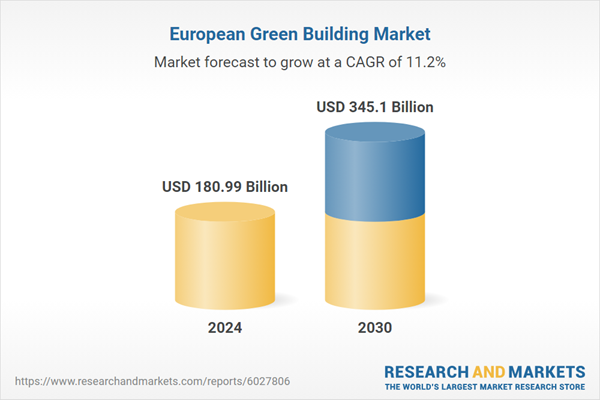Speak directly to the analyst to clarify any post sales queries you may have.
10% Free customizationThis report comes with 10% free customization, enabling you to add data that meets your specific business needs.
Green buildings aim to reduce carbon emissions, improve energy performance, and foster healthier indoor environments by incorporating technologies such as energy-efficient HVAC systems, solar power installations, and water-saving solutions. Growth in this sector is being driven by strict regulatory frameworks, including the European Union’s Green Deal and commitments under the Paris Agreement. Rising environmental awareness and increasing demand for sustainable residential and commercial developments are also fueling momentum across the region.
Key Market Drivers
Stringent Government Regulations and Policies Supporting Sustainability
A major growth driver in the Europe Green Building Market is the implementation of rigorous government regulations and sustainability policies. European nations are aligning with ambitious climate targets, including the European Green Deal, which aims to make the continent climate-neutral by 2050. These directives require major transformations in construction practices to enhance energy efficiency and lower carbon emissions.To meet these goals, new and existing buildings are subject to strict energy performance standards. The Energy Performance of Buildings Directive (EPBD), for instance, mandates that all new constructions in the EU be nearly zero-energy buildings (NZEB), with full implementation effective from 2023. This policy, coupled with the fact that over 75% of existing EU buildings are energy inefficient, is accelerating large-scale green renovations and driving the adoption of sustainable construction techniques. National and regional authorities across Europe are continuously updating legislation to ensure buildings contribute meaningfully to climate neutrality objectives.
Key Market Challenges
High Initial Investment and Construction Costs
A significant challenge facing the Europe Green Building Market is the elevated upfront cost associated with constructing sustainable buildings. These projects often require premium materials, renewable energy systems, and advanced energy-efficient technologies, all of which increase capital expenditures. For example, integrating solar panels, geothermal heating, or low-carbon construction materials like cross-laminated timber and recycled steel adds to initial costs.Labor costs are also typically higher, as green building projects demand professionals skilled in sustainable design, BIM (Building Information Modeling), and innovative construction methods. Specialists are required to install smart HVAC systems, energy-efficient lighting, and water conservation devices, increasing technical and labor-related expenses. These higher initial costs can act as a deterrent for developers, especially when the long-term operational savings and environmental benefits are not immediately quantifiable or valued by stakeholders. As a result, cost remains a barrier to widespread adoption, particularly in markets where financial incentives or regulatory enforcement is limited.
Key Market Trends
Increasing Adoption of Smart Building Technologies
An emerging trend in the Europe Green Building Market is the widespread incorporation of smart technologies aimed at enhancing building performance and energy efficiency. As buildings evolve to meet stricter sustainability standards, technologies such as smart HVAC systems, automated lighting, and real-time energy monitoring are being integrated to optimize resource use and reduce emissions.The use of IoT (Internet of Things) is transforming green building management. Smart sensors monitor occupancy and environmental conditions, enabling automatic adjustments in lighting and climate control to minimize energy waste. Building management systems (BMS) are increasingly connected with renewable energy sources, enabling intelligent optimization of energy consumption and production.
By 2024, over 40% of new commercial buildings in Western Europe incorporated automation systems for lighting, HVAC, and security - critical to achieving certifications like BREEAM and LEED. These technologies are driving progress toward net-zero energy targets while also aligning with digital transformation trends in the construction sector. As innovation advances, smart solutions will become integral to sustainable building practices across both new constructions and retrofitting projects.
Key Market Players
- Skanska UK Plc
- Compagnie de Saint-Gobain
- Kingspan Holdings (Ireland) Limited
- VINCI SA
- Balfour Beatty plc
- Bouygues (U.K.) Limited
- HOCHTIEF Aktiengesellschaft
- Strabag SE
- CRH plc
- Holcim Ltd.
Report Scope:
In this report, the Europe Green Building Market has been segmented into the following categories, in addition to the industry trends which have also been detailed below:Europe Green Building Market, By Product Type:
- Exterior Products
- Interior Products
Europe Green Building Market, By Application:
- Residential Buildings
- Commercial Buildings
- Industrial Buildings
Europe Green Building Market, By End-user Industry:
- New Constructions
- Renovations
Europe Green Building Market, By Country:
- Germany
- Italy
- France
- Spain
- Netherlands
- Belgium
- United Kingdom
- Rest of Europe
Competitive Landscape
Company Profiles: Detailed analysis of the major companies present in the Europe Green Building Market.Available Customizations:
With the given market data, the publisher offers customizations according to a company's specific needs. The following customization options are available for the report.Company Information
- Detailed analysis and profiling of additional market players (up to five).
This product will be delivered within 1-3 business days.
Table of Contents
Companies Mentioned
- Skanska UK Plc
- Compagnie de Saint-Gobain.
- Kingspan Holdings (Ireland) Limited
- VINCI SA
- Balfour Beatty plc
- Bouygues (U.K.) Limited.
- HOCHTIEF Aktiengesellschaft.
- Strabag SE
- CRH plc
- Holcim Ltd.
Table Information
| Report Attribute | Details |
|---|---|
| No. of Pages | 134 |
| Published | July 2025 |
| Forecast Period | 2024 - 2030 |
| Estimated Market Value ( USD | $ 180.99 Billion |
| Forecasted Market Value ( USD | $ 345.1 Billion |
| Compound Annual Growth Rate | 11.1% |
| Regions Covered | Europe |
| No. of Companies Mentioned | 10 |









